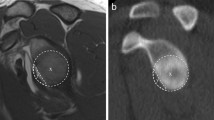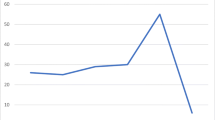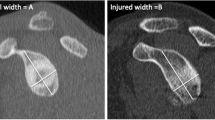Abstract
Purpose
The aim of the current study was to compare the diagnostic precision and reliability of different methods in measuring Hill–Sachs lesions (HSLs) using MRI and CT.
Methods
A total of 80 consecutive patients with a history of anterior shoulder instability were retrospectively included. The preoperative CT and MRI scans of the affected shoulders were analysed. To investigate the ability of the Franceschi grading, Calandra classification, Richards, Hall, and Rowe grading scale, Flatow percentage and “glenoid track” assessment according to Di Giacomo et al. to quantify the extent of humeral bone loss, the results of each measurement method obtained with MRI were compared with those achieved with CT. In addition, the intra- and inter-rater reliabilities of each measurement method using CT and MRI were calculated and compared.
Results
A significant difference was found between CT and MRI in the determination of the Hill–Sachs interval (HSI) (p = 0.016), but not between the results of any of the other measurement techniques. With the exceptions of the Franceschi grade and Calandra classification, all measurement methods showed good or excellent intra- and inter-rater reliabilities for both MRI and CT.
Conclusions
While the determination of the HSI with MRI was more accurate, all other analysed techniques for measuring the amount of humeral bone loss showed similar diagnostic precision. With regard to the intra- and inter-rater reliabilities, all measurement techniques analysed, with the exception of the Franceschi and Calandra classifications, provided good to very good reliabilities with both CT and MRI.
Level of evidence
III




Similar content being viewed by others
References
Alentorn-Geli E, Álvarez-Díaz P, Doblas J, Steinbacher G, Seijas R, Ares O, Boffa JJ, Cuscó X, Cugat R (2016) Return to sports after arthroscopic capsulolabral repair using knotless suture anchors for anterior shoulder instability in soccer players: minimum 5-year follow-up study. Knee Surg Sports Traumatol Arthrosc 24:440–446
Alkaduhimi H, Saarig A, Amajjar I, van der Linde JA, van Wier MF, Willigenburg NW, van den Bekerom MPJ, Shoulder and Elbow Center (2021) Interobserver agreement for detecting Hill-Sachs lesions on magnetic resonance imaging. Clin Shoulder Elb 24:98–105
Åman M, Forssblad M, Larsén K (2019) National injury prevention measures in team sports should focus on knee, head, and severe upper limb injuries. Knee Surg Sports Traumatol Arthrosc 27:1000–1008
Ando A, Hagiwara Y, Sekiguchi T, Koide M, Kanazawa K, Watanabe T, Itoi E (2017) Magnetic resonance imaging classification of haemodialysis-related amyloidosis of the shoulder: risk factors and arthroscopic treatment. Knee Surg Sports Traumatol Arthrosc 25:2217–2224
Auffarth A, Mayer M, Kofler B, Hitzl W, Bogner R, Moroder P, Korn G, Koller H, Resch H (2013) The interobserver reliability in diagnosing osseous lesions after first-time anterior shoulder dislocation comparing plain radiographs with computed tomography scans. J Shoulder Elbow Surg 22:1507–1513
Bak K, Randelli P, Lorbach O (2016) Theme issue shoulder instability. Knee Surg Sports Traumatol Arthrosc 24:303–304
Barlow B, Metzger P, Peace W, Leonardelli D, Solomon D, Provencher M (2010) Clinical grading of Hill-Sachs injuries: association with glenoid bone loss and clinical application of the “glenoid track” concept in terms of humeral head engagement (SS-13). Arthroscopy 26:e7
Brilakis E, Avramidis G, Malahias M-A, Stathellis A, Deligeorgis A, Chiotis I, Mataragas E, Chronopoulos E, Antonogiannakis E (2019) Long-term outcome of arthroscopic remplissage in addition to the classic Bankart repair for the management of recurrent anterior shoulder instability with engaging Hill-Sachs lesions. Knee Surg Sports Traumatol Arthrosc 27:305–313
Calandra JJ, Baker CL, Uribe J (1989) The incidence of Hill-Sachs lesions in initial anterior shoulder dislocations. Arthroscopy 5:254–257
Calvo C, Calvo J, Rojas D, Valencia M, Calvo E (2021) Clinical relevance of persistent off-track Hill-Sachs lesion after arthroscopic Latarjet procedure. Am J Sports Med. https://doi.org/10.1177/03635465211019979
Chen K-H, Yang T-C, Chiang E-R, Wang H-Y, Ma H-L (2021) The Hill-Sachs interval to glenoid track width ratio is comparable to the instability severity index score for predicting risk of recurrent instability after arthroscopic Bankart repair. Knee Surg Sports Traumatol Arthrosc 29:250–256
Cho SH, Cho NS, Rhee YG (2011) Preoperative analysis of the Hill-Sachs lesion in anterior shoulder instability: how to predict engagement of the lesion. Am J Sports Med 39:2389–2395
Di Giacomo G, de Gasperis N, Scarso P (2016) Bipolar bone defect in the shoulder anterior dislocation. Knee Surg Sports Traumatol Arthrosc 24:479–488
Di Giacomo G, Itoi E, Burkhart SS (2014) Evolving concept of bipolar bone loss and the Hill-Sachs lesion: from “engaging/non-engaging” lesion to “on-track/off-track” lesion. Arthroscopy 30:90–98
Ding Z, Cong S, Xie Y, Feng S, Chen S, Chen J (2020) Location of the suture anchor in Hill-Sachs lesion could influence glenohumeral cartilage quality and limit range of motion after arthroscopic Bankart repair and remplissage. Am J Sports Med 48:2628–2637
Dyrna FGE, Ludwig M, Imhoff AB, Martetschläger F (2020) Off-track Hill-Sachs lesions predispose to recurrence after nonoperative management of first-time anterior shoulder dislocations. Knee Surg Sports Traumatol Arthrosc. https://doi.org/10.1007/s00167-020-06176-1
Flatow EL, Warner JI (1998) Instability of the shoulder: complex problems and failed repairs: Part I. Relevant biomechanics, multidirectional instability, and severe glenoid loss. Instr Course Lect 47:97–112
Franceschi F, Longo UG, Ruzzini L, Rizzello G, Maffulli N, Denaro V (2008) Arthroscopic salvage of failed arthroscopic Bankart repair: a prospective study with a minimum follow-up of 4 years. Am J Sports Med 36:1330–1336
Funakoshi T, Hartzler RU, Stewien E, Burkhart SS (2019) Hill-Sachs lesion classification by the glenoid track paradigm in shoulder instability: poor agreement between 3-dimensional computed tomographic and arthroscopic methods. Arthrosc J Arthrosc Relat Surg 35:1743–1749
Golijanin P, Peebles L, Arner JW, Douglass B, Peebles A, Rider D, Ninkovic S, Midtgaard K, Provencher MT (2021) Advanced 3-dimensional characterization of Hill-Sachs lesions in 100 anterior shoulder instability patients. Arthroscopy; https://doi.org/10.1016/j.arthro.2021.05.015
Guyatt GH, Mills EJ, Elbourne D (2008) In the era of systematic reviews, does the size of an individual trial still matter? PLoS Med 5(1):e4. https://doi.org/10.1371/journal.pmed.0050004
Haeni D, Sanchez M, Johannes P, Victoria L, Henderson D, Munji J, Petkin K, Lafosse L (2018) Arthroscopic double bone block augmentation is a salvage procedure for anterior and posterior shoulder instability secondary to glenoid bone loss. Knee Surg Sports Traumatol Arthrosc 26:2447–2453
Hall RH, Isaac F, Booth CR (1959) Dislocations of the shoulder with special reference to accompanying small fractures. J Bone Joint Surg Am 41-A:489–494
Haroun HK, Sobhy MH, Abdelrahman AA (2020) Arthroscopic Bankart repair with remplissage versus Latarjet procedure for management of engaging Hill-Sachs lesions with subcritical glenoid bone loss in traumatic anterior shoulder instability: a systematic review and meta-analysis. J Shoulder Elbow Surg 29:2163–2174
Ho A, Kurdziel MD, Koueiter DM, Wiater JM (2018) Three-dimensional computed tomography measurement accuracy of varying Hill-Sachs lesion size. J Shoulder Elbow Surg 27:350–356
Hovelius L, Rahme H (2016) Primary anterior dislocation of the shoulder: long-term prognosis at the age of 40 years or younger. Knee Surg Sports Traumatol Arthrosc 24:330–342
Jia B, Lynn HS (2015) A sample size planning approach that considers both statistical significance and clinical significance. Trials 16:213
Kirkley A, Litchfield R, Thain L, Spouge A (2003) Agreement between magnetic resonance imaging and arthroscopic evaluation of the shoulder joint in primary anterior dislocation of the shoulder. Clin J Sport Med 13:148–151
Kodali P, Jones MH, Polster J, Miniaci A, Fening SD (2011) Accuracy of measurement of Hill-Sachs lesions with computed tomography. J Shoulder Elbow Surg 20:1328–1334
Kurokawa D, Yamamoto N, Nagamoto H, Omori Y, Tanaka M, Sano H, Itoi E (2013) The prevalence of a large Hill-Sachs lesion that needs to be treated. J Shoulder Elbow Surg 22:1285–1289
Lee Y-J, Kim C, Kim S-J, Yoon T-H, Cho J-Y, Chun Y-M (2021) Does an “off-track” Hill-Sachs lesion that is misclassified as “non-engaging” affect outcomes from Bankart repair alone compared with Bankart repair combined with Remplissage? Arthroscopy 37:450–456
Longo UG, Loppini M, Rizzello G, Romeo G, Huijsmans PE, Denaro V (2014) Glenoid and humeral head bone loss in traumatic anterior glenohumeral instability: a systematic review. Knee Surg Sports Traumatol Arthrosc 22:392–414
MacDonald P, McRae S, Old J, Marsh J, Dubberley J, Stranges G, Koenig J, Leiter J, Mascarenhas R, Prabhakar S, Sasyniuk T, Lapner P (2021) Arthroscopic Bankart repair with and without arthroscopic infraspinatus remplissage in anterior shoulder instability with a Hill-Sachs defect: a randomized controlled trial. J Shoulder Elbow Surg 30:1288–1298
Maio M, Sarmento M, Moura N, Cartucho A (2019) How to measure a Hill-Sachs lesion: a systematic review. EFORT Open Rev 4:151–157
Ozaki R, Nakagawa S, Mizuno N, Mae T, Yoneda M (2014) Hill-Sachs lesions in shoulders with traumatic anterior instability: evaluation using computed tomography with 3-dimensional reconstruction. Am J Sports Med 42:2597–2605
Provencher MT, Frank RM, Leclere LE, Metzger PD, Ryu JJ, Bernhardson A, Romeo AA (2012) The Hill-Sachs lesion: diagnosis, classification, and management. J Am Acad Orthop Surg 20:242–252
Richards RD, Sartoris DJ, Pathria MN, Resnick D (1994) Hill-Sachs lesion and normal humeral groove: MR imaging features allowing their differentiation. Radiology 190:665–668
Riebe B, Micheas L, Crim J (2021) Improving detection of Hill-Sachs fractures on radiographs. Skeletal Radiol. https://doi.org/10.1007/s00256-021-03763-2
Rowe CR, Zarins B, Ciullo JV (1984) Recurrent anterior dislocation of the shoulder after surgical repair. Apparent causes of failure and treatment. J Bone Joint Surg Am 66:159–168
Saito H, Itoi E, Minagawa H, Yamamoto N, Tuoheti Y, Seki N (2009) Location of the Hill-Sachs lesion in shoulders with recurrent anterior dislocation. Arch Orthop Trauma Surg 129:1327–1334
Saliken DJ, Bornes TD, Bouliane MJ, Sheps DM, Beaupre LA (2015) Imaging methods for quantifying glenoid and Hill-Sachs bone loss in traumatic instability of the shoulder: a scoping review. BMC Musculoskelet Disord 16:164
Stillwater L, Koenig J, Maycher B, Davidson M (2017) 3D-MR vs. 3D-CT of the shoulder in patients with glenohumeral instability. Skeletal Radiol 46:325–331
Tasaki A, Morita W, Nozaki T, Yonekura Y, Saito M, Phillips BB, Kitamura N (2021) Arthroscopic Bankart repair and open Bristow procedure in the treatment of anterior shoulder instability with osseous glenoid lesions in collision athletes. Orthop J Sports Med. https://doi.org/10.1177/23259671211008274 (eCollection 2021)
Tat J, Crawford J, Chong J, Powell T, Fevens TG, Popa T, Martineau PA (2021) Three-dimensional (3D) animation and calculation for the assessment of engaging Hill-Sachs lesions with computed tomography 3D reconstruction. Arthrosc Sports Med Rehabil 3:e89–e96
Verweij LPE, van Deurzen DFP, van den Bekerom MPJ (2021) Accurate assessment of the Hill-Sachs lesion: there is no information about the accuracy of quantification of these lesions. Arthroscopyopy 37:432–433
Vopat ML, Peebles LA, McBride T, Cirone I, Rider D, Provencher CMT (2020) Accuracy and reliability of imaging modalities for the diagnosis and quantification of Hill-Sachs lesions: a systematic review. Arthroscopy. https://doi.org/10.1016/j.arthro.2020.08.005
Vopat ML, Peebles LA, McBride T, Cirone I, Rider D, Provencher CMT (2021) Accuracy and reliability of imaging modalities for the diagnosis and quantification of Hill-Sachs lesions: a systematic review. Arthroscopy 37:391–401
Yamamoto N, Shinagawa K, Hatta T, Itoi E (2020) Peripheral-track and central-track Hill-Sachs lesions: a new concept of assessing an on-track lesion. Am J Sports Med 48:33–38
Yu JS, Rink T, Yu SM, Liu K, Carver K, Lather JD, Payne J, Rogers A, Erdal BS (2021) The broken circle method: a novel technique that enhances detection of Hill-Sachs lesions on internal rotation shoulder radiographs. Clin Radiol 76(158):e1-158.e12
Funding
No funding was received related to the subject of this article.
Author information
Authors and Affiliations
Corresponding author
Ethics declarations
Conflict of interest
The authors, their immediate family, and any research foundation with which they are affiliated have not received any financial payments or other benefits from any commercial entity related to the subject of this article.
Ethical approval
This study was approved by our institutional ethical board (University of Ulm, application 154/20).
Additional information
Publisher's Note
Springer Nature remains neutral with regard to jurisdictional claims in published maps and institutional affiliations.
Rights and permissions
About this article
Cite this article
Sgroi, M., Huzurudin, H., Ludwig, M. et al. With the exception of the Hill–Sachs interval, CT and MRI show no significant differences in the diagnostic value of the HSL measurement regardless of the measurement technique. Knee Surg Sports Traumatol Arthrosc 29, 3981–3988 (2021). https://doi.org/10.1007/s00167-021-06695-5
Received:
Accepted:
Published:
Issue Date:
DOI: https://doi.org/10.1007/s00167-021-06695-5




